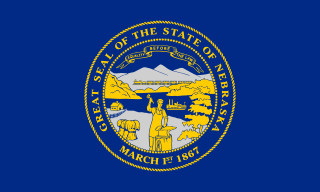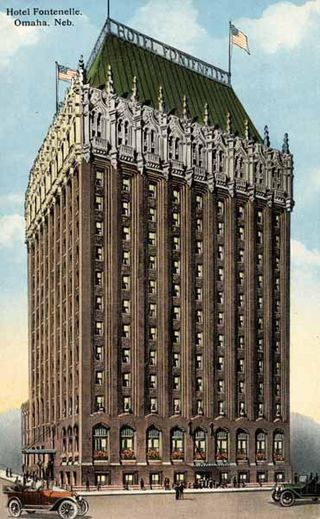
Nebraska is a state in the Midwestern region of the United States. It is bordered by South Dakota to the north; Iowa to the east and Missouri to the southeast, both across the Missouri River; Kansas to the south; Colorado to the southwest; and Wyoming to the west. It is the only triply landlocked U.S. state.

Omaha is the largest city in the U.S. state of Nebraska and the county seat of Douglas County. Omaha is in the Midwestern United States on the Missouri River, about 10 mi (15 km) north of the mouth of the Platte River. The nation's 39th-largest city, Omaha's 2020 census population was 486,051.

Omaha Public Schools (OPS) is the largest school district in the state of Nebraska, United States. This public school district serves a diverse community of about 52,000 students at over 80 elementary and secondary schools in Omaha. Its district offices are located in the former Tech High at 30th and Cuming Streets.

The Omaha metropolitan area, officially known as the Omaha–Council Bluffs, NE–IA, Metropolitan Statistical Area (MSA), is an urbanized region in Nebraska and Iowa in the American Midwest, centered on the city of Omaha, Nebraska. The region consists of eight counties, and extends over a large area on both sides of the Missouri River. Covering 4,407 square miles (11,410 km2) and with a population of 967,604 (2020), the Omaha metropolitan area is the most populous in both Nebraska and Iowa, and is the 58th most populous MSA in the United States. The 2003 revision to metropolitan area definitions was accompanied by the creation of micropolitan areas and combined statistical areas. Fremont, in Dodge County, Nebraska, was designated a micropolitan area. The Omaha–Council Bluffs–Fremont Combined Statistical Area has a population of 1,058,125 . Approximately 1.5 million people reside within the Greater Omaha area, within a 50 mi (80 km) radius of Downtown Omaha.
Florence is a neighborhood in Omaha, Nebraska, United States on the city's north end and originally one of the oldest cities in Nebraska. It was incorporated by the Nebraska Territorial Legislature on March 10, 1857. The site of Winter Quarters for Mormon migrants traveling west, it has the oldest cemetery for people of European descent and oldest standing gristmill in Nebraska. Florence was the site of an illegal territorial legislature in 1858. Given the high concentration of National Register of Historic Places in the neighborhood, it is regarded as "the historic front door to Omaha as well as the state."
The civil rights movement in Omaha, Nebraska, has roots that extend back until at least 1912. With a history of racial tension that starts before the founding of the city, Omaha has been the home of numerous overt efforts related to securing civil rights for African Americans since at least the 1870s.

The history of Omaha, Nebraska, began before the settlement of the city, with speculators from neighboring Council Bluffs, Iowa staking land across the Missouri River illegally as early as the 1840s. When it was legal to claim land in Indian Country, William D. Brown was operating the Lone Tree Ferry to bring settlers from Council Bluffs to Omaha. A treaty with the Omaha Tribe allowed the creation of the Nebraska Territory, and Omaha City was founded on July 4, 1854. With early settlement came claim jumpers and squatters, and the formation of a vigilante law group called the Omaha Claim Club, which was one of many claim clubs across the Midwest. During this period many of the city's founding fathers received lots in Scriptown, which was made possible by the actions of the Omaha Claim Club. The club's violent actions were challenged successfully in a case ultimately decided by the U.S. Supreme Court, Baker v. Morton, which led to the end of the organization.
Racial tension in Omaha, Nebraska occurred mostly because of the city's volatile mixture of high numbers of new immigrants from southern and eastern Europe and African-American migrants from the Deep South. While racial discrimination existed at several levels, the violent outbreaks were within working classes. Irish Americans, the largest and earliest immigrant group in the 19th century, established the first neighborhoods in South Omaha. All were attracted by new industrial jobs and most were from rural areas. There was competition among ethnic Irish, newer European immigrants, and African-American migrants from the South, for industrial jobs and housing. They all had difficulty adjusting to industrial demands, which were unmitigated by organized labor in the early years. Some of the early labor organizing resulted in increasing tensions between groups, as later arrivals to the city were used as strikebreakers. In Omaha as in other major cities, racial tension has erupted at times of social and economic strife, often taking the form of mob violence as different groups tried to assert power. Much of the early violence came out of labor struggles in early 20th century industries: between working class ethnic whites and immigrants, and blacks of the Great Migration. Meatpacking companies had used the latter for strikebreakers in 1917 as workers were trying to organize. As veterans returned from World War I, both groups competed for jobs. By the late 1930s, however, interracial teams worked together to organize the meatpacking industry under the United Packinghouse Workers of America (UPWA). Unlike the AFL and some other industrial unions in the CIO, UPWA was progressive. It used its power to help end segregation in restaurants and stores in Omaha, and supported the civil rights movement in the 1960s. Women labor organizers such as Tillie Olsen and Rowena Moore were active in the meatpacking industry in the 1930s and 1940s, respectively.

Holy Family Church was built in 1883 at 1715 Izard Street, at the intersections of 18th and Izard Streets in North Omaha, Nebraska within the Roman Catholic Archdiocese of Omaha. It is the oldest existing Catholic Church in Omaha, and is listed on the National Register of Historic Places.

The Bemis Park Landmark Heritage District is located in North Omaha, Nebraska. Situated from Cuming Street to Hawthorne Avenue, Glenwood Avenue to 33rd Street, Bemis Park was annexed into Omaha in 1887, and developed from 1889-1922. The district was designated an Omaha Landmark in 1983.

Sacred Heart Catholic Church is located at 2206 Binney Street in the Kountze Place neighborhood of North Omaha, Nebraska within the Roman Catholic Archdiocese of Omaha.

The Sherman is a historically significant apartment building located at 2501 North 16th Street in the Near North Side of Omaha, Nebraska. Built in 1897, it was designated an Omaha landmark in 1985; in 1986 it was listed on the National Register of Historic Places.

The economy of Omaha, Nebraska is linked to the city's status as a major commercial hub in the Midwestern United States since its founding in 1854. Dubbed the "Motor Mouth City" by The New York Times, Omaha is widely regarded as the telecommunications capital of the United States. The city's economy includes agriculture, food processing, insurance, transportation, healthcare and education. Warren Buffett of Berkshire Hathaway has lived in Omaha all of his life, as have the ConAgra Foods, Union Pacific Railroad and Mutual of Omaha Companies, and Kiewit Corporation, all Fortune 500 corporations.
African Americans in Omaha, Nebraska are central to the development and growth of the 43rd largest city in the United States. The first free black settler in the city arrived in 1854, the year the city was incorporated. In 1894 black residents of Omaha organized the first fair in the United States for African-American exhibitors and attendees. The 2000 US Census recorded 51,910 African Americans as living in Omaha. In the 19th century, the growing city of Omaha attracted ambitious people making new lives, such as Dr. Matthew Ricketts and Silas Robbins. Dr. Ricketts was the first African American to graduate from a Nebraska college or university. Silas Robbins was the first African American to be admitted to the bar in Nebraska. In 1892 Dr. Ricketts was also the first African American to be elected to the Nebraska State Legislature. Ernie Chambers, an African-American barber from North Omaha's 11th District, became the longest serving state senator in Nebraska history in 2005 after serving in the unicameral for more than 35 years.

The government of the City of Omaha, Nebraska consists of the Mayor of Omaha, the Omaha City Council and various departments of the City of Omaha, which is located in Douglas County, Nebraska. The city of Omaha was founded in 1854 and incorporated in 1857.

Boulevards in Omaha are part of a park and boulevard system originally designed in 1889 by Horace Cleveland. There are more than one hundred miles (160 km) of boulevards throughout the city of Omaha, Nebraska today.
The Irish in Omaha, Nebraska have constituted a major ethnic group throughout the history of the city, and continue to serve as important religious and political leaders. They compose a large percentage of the local population.

The 2021 Omaha mayoral election was held in 2021. Incumbent Republican mayor Jean Stothert was re-elected to a third term in office. Stothert is the first person elected to a third consecutive term as mayor of Omaha in the modern era.















